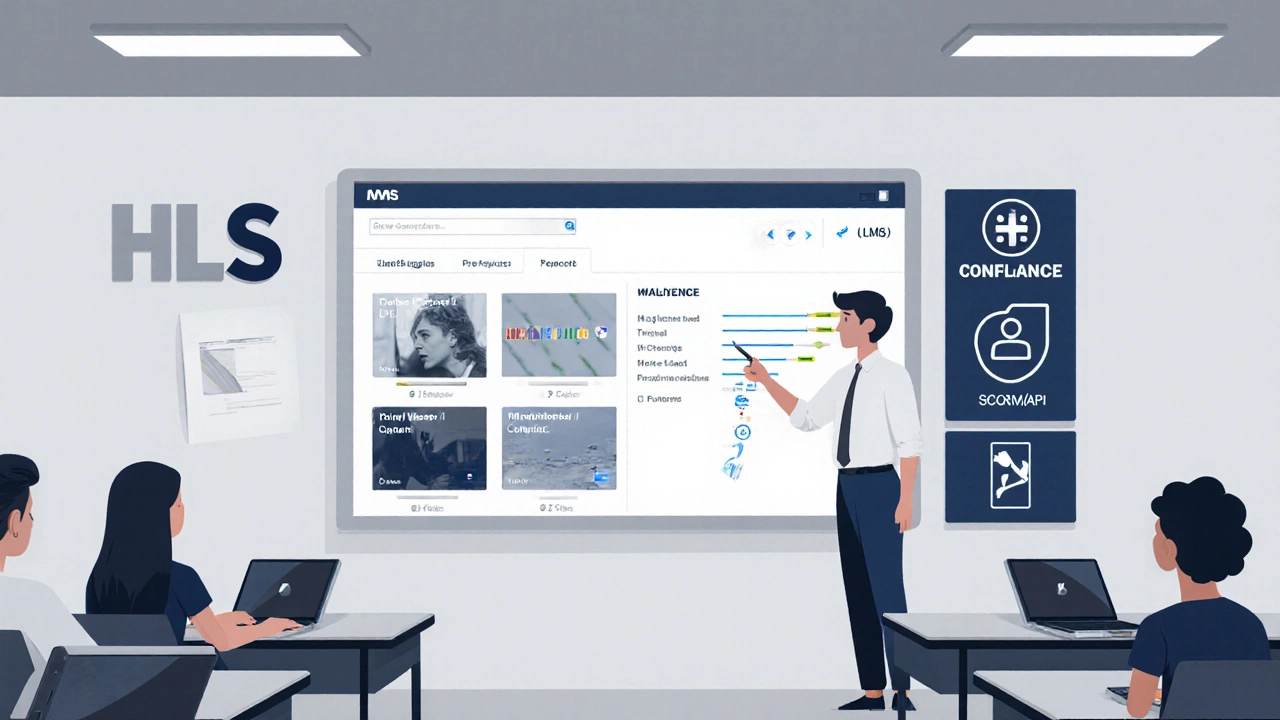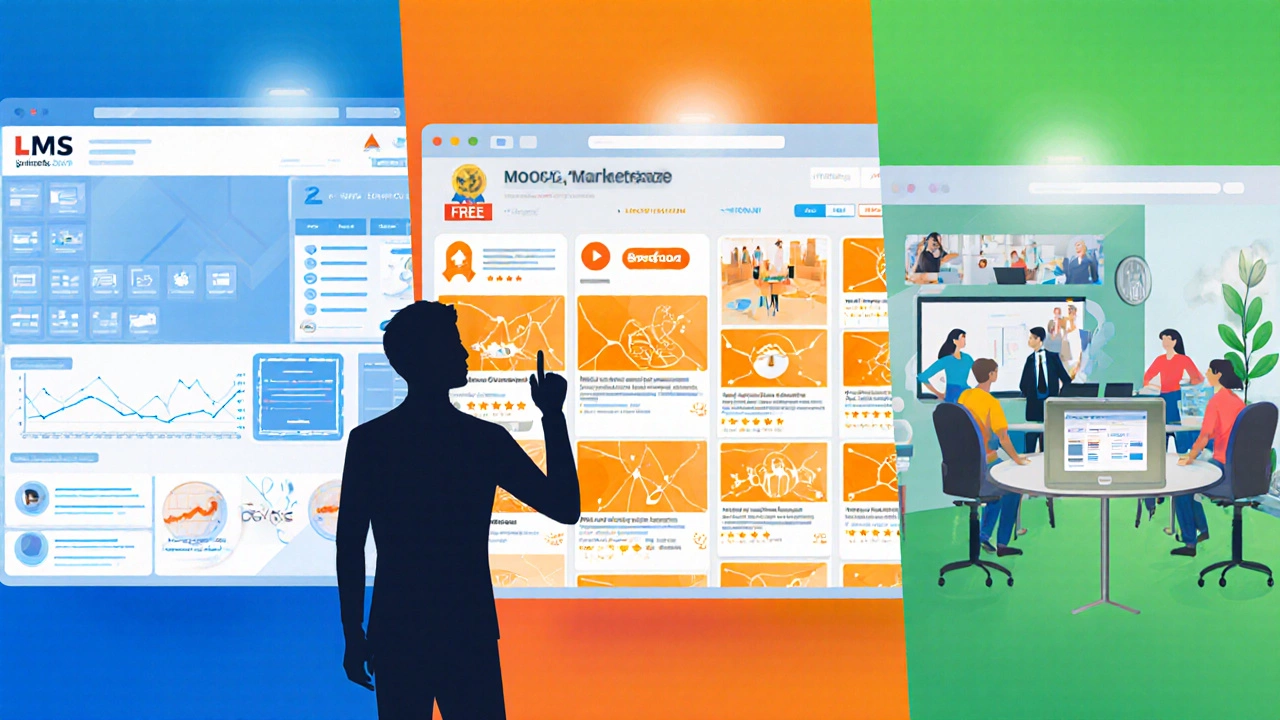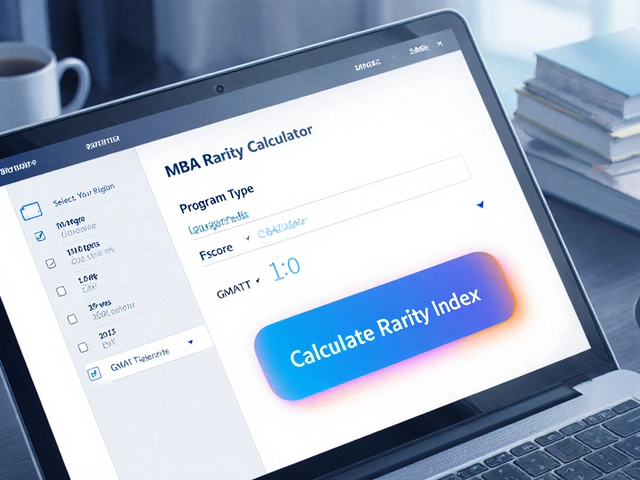
E-learning Platform Selector
Which E-learning Platform Is Right for You?
Answer these questions to find the platform type that best matches your needs. The tool will analyze your responses and provide a personalized recommendation.
Your Recommended E-learning Platform Type
Understanding the landscape of e-learning platforms is essential for anyone wanting to study, teach, or train online. The market is crowded, but most solutions fall into three clear families, each built for a different learning style and audience. This guide breaks down the three types, shows how they differ, and helps you pick the right one for your goals.
Understanding E‑learning Platforms
When you hear the term E‑learning platform is a software service that delivers educational content over the internet, you’re dealing with a digital hub that hosts courses, tracks progress, and often powers certificates. These platforms can be pure content libraries, full‑blown course management suites, or live‑session tools. Regardless of the branding, they all share three core attributes:
- Content delivery - videos, PDFs, quizzes, or interactive simulations.
- Learner tracking - dashboards that show completion rates, scores, and engagement.
- Interaction mechanisms - discussion boards, peer review, or real‑time video chat.
How they combine these features determines which of the three main types you’re looking at.
1. Learning Management Systems (LMS)
A Learning Management System (LMS) is a centralized portal designed for organizations to create, deliver, and manage structured learning programs. Typical attributes include:
- Target audience: Corporations, universities, and K‑12 districts.
- Key features: Course authoring tools, compliance tracking, SCORM/Tin Can (xAPI) support, role‑based permissions.
- Pricing model: Per‑user subscription, often tiered by storage or feature set.
Popular examples are Moodle (open‑source, highly customizable), Canvas (cloud‑first, strong analytics), and Blackboard (enterprise‑grade with deep integration).
Because LMSs focus on administration and reporting, they excel at mandatory training (e.g., safety modules) and credit‑bearing academic programs.
2. Massive Open Online Course (MOOC) Platforms
A MOOC platform is a marketplace that hosts thousands of stand‑alone courses from multiple providers, often at low or no cost. Core traits include:
- Target audience: Individual learners seeking skill upgrades or personal enrichment.
- Key features: Video‑centric lectures, peer‑graded assignments, discussion forums, and optional certificates.
- Pricing model: Free access to content; paid certificates or subscriptions for extra features.
Leading MOOC sites are Coursera (partners with universities), edX (Harvard‑MIT collaboration), and Udacity (nanodegree focus). These platforms prioritize scale and discoverability, making them ideal for hobbyists and professionals who want to sample many topics.

3. Virtual Classroom Platforms
A Virtual classroom platform enables live, interactive sessions that mimic a physical classroom. Main attributes are:
- Target audience: Schools, tutoring services, and corporate trainers who need real‑time engagement.
- Key features: Synchronous video, breakout rooms, live whiteboard, attendance tracking, and real‑time polls.
- Pricing model: Per‑host or per‑seat licensing, often bundled with video‑conference bandwidth.
Examples include Zoom for Education (wide adoption, API integration), Microsoft Teams (deep Office 365 tie‑in), and BigBlueButton (open‑source, strong LMS integration).
Virtual classrooms shine when immediate feedback, group work, or instructor presence is crucial - think language lessons, labs, or corporate webinars.
Choosing the Right Type for Your Needs
Below is a quick side‑by‑side comparison that helps you line up your requirements with the platform type that best fits.
| Feature | LMS | MOOC Platform | Virtual Classroom |
|---|---|---|---|
| Primary Use‑Case | Structured programs & compliance | Self‑paced skill courses | Live instruction & interaction |
| Typical Audience | Enterprises, universities | Individual learners | Schools, corporate trainers |
| Content Creation | Built‑in authoring or SCORM import | Provider‑generated videos | Instructor‑led video streams |
| Assessment Methods | Quizzes, graded assignments, certifications | Auto‑graded quizzes, peer review | Live polls, real‑time quizzes |
| Pricing Model | Per‑user subscription | Free content, paid certificates | Per‑host or per‑seat license |
| Scalability | High (enterprise‑grade) | Massive - millions of users | Medium - limited by bandwidth |
Ask yourself these three questions before committing:
- Do I need structured pathways with compliance reporting? If yes, an LMS is the safest bet.
- Am I looking for a catalog of diverse, on‑demand courses? Then a MOOC platform will serve you best.
- Is real‑time interaction a must‑have? A virtual classroom will give you the live feel you need.

Key Checklist for Selecting an E‑learning Platform
- Integration capabilities: API support for HRIS, student information systems, or CRM.
- Accessibility compliance: WCAG 2.1 AA at minimum.
- Mobile experience: Native apps or responsive design for iOS/Android.
- Data security: End‑to‑end encryption, GDPR compliance if you serve EU learners.
- Analytics depth: Ability to drill down from cohort performance to individual activity logs.
- Support & community: 24/7 help desk, active user forums, and regular feature updates.
Common Pitfalls to Avoid
Even seasoned educators stumble when they chase shiny features. Here are three traps to watch out for:
- Choosing based on price alone. The cheapest option often lacks scalability or compliance tools you’ll need later.
- Ignoring learner experience. Complex navigation kills engagement; run a pilot with real users before a full rollout.
- Over‑customizing. Deep custom code can lock you into a vendor and make upgrades painful. Stick to native features whenever possible.
By keeping these warnings in mind, you’ll avoid costly re‑platforming down the line.
Frequently Asked Questions
What’s the main difference between an LMS and a MOOC platform?
An LMS focuses on managing structured, often mandatory, learning programs with detailed reporting and compliance tools. A MOOC platform, on the other hand, offers a large catalog of self‑paced courses that anyone can enroll in, usually for free or a low fee.
Can I use a virtual classroom as a replacement for an LMS?
Not usually. Virtual classrooms excel at live interaction but lack the deep tracking, certification workflows, and bulk course management that an LMS provides. For a blended approach, many institutions pair a virtual classroom with an LMS.
Which type is best for corporate compliance training?
A Learning Management System is the clear winner because it supports SCORM/xAPI, tracks completion dates, and can generate audit‑ready reports required by regulators.
Do MOOC platforms offer certificates that are recognized by employers?
Many do. Platforms like Coursera and edX partner with accredited universities, so their paid certificates often carry university branding and can appear on LinkedIn, which many recruiters respect.
How important is mobile support for e‑learning success?
Extremely important. Studies in 2024 show that 68% of learners access content on smartphones or tablets. Platforms that lack a responsive design see higher drop‑off rates.




